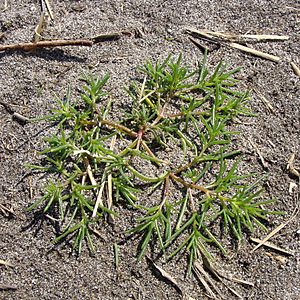Salsola komarovii facts for kids
Quick facts for kids Salsola komarovii |
|
|---|---|
 |
|
| In Aomori, Japan | |
| Scientific classification | |
| Synonyms | |
|
Kali komarovii (Iljin) Akhani & Roalson |
Salsola komarovii is a cool plant that grows every year from a seed. It's known by a special Japanese name: okahijiki. This name means "land seaweed" because it looks a bit like seaweed, but it grows on land!
This plant is native to several places in Asia. You can find it growing naturally in China, Korea, Japan, and parts of eastern Russia. It's not just a wild plant; people also grow it on farms because its leaves and young shoots are yummy to eat.
Contents
What is Okahijiki?
Okahijiki is a type of plant that belongs to the Amaranthaceae family. This family also includes other well-known plants like spinach and quinoa. Okahijiki is an annual plant, which means it completes its whole life cycle in just one year. It sprouts from a seed, grows, produces its own seeds, and then dies, all within a single growing season.
Where Does Okahijiki Grow?
This plant loves coastal areas. It often grows in sandy soils near the sea. It can handle salty conditions, which is why it thrives in places where other plants might struggle. Its natural home stretches across a wide area in East Asia. This includes the coasts of Japan, the Korean Peninsula, and parts of China and Russia.
How Tall Does Okahijiki Get?
Okahijiki is not a very tall plant. It usually grows to be about 20 to 50 centimeters high. That's roughly the height of a standard school ruler, or maybe a bit taller! Its stems are often reddish, and its leaves are long and thin, looking a bit like green needles.
How People Use Okahijiki
People mostly grow and eat okahijiki as a vegetable. It's especially popular in Japanese cooking. The young, tender shoots and leaves are the parts that are eaten. They have a crisp texture and a mild, slightly salty taste.
Cooking with Okahijiki
Okahijiki can be used in many different dishes. It's often blanched quickly, which means it's dipped in boiling water for a short time. After blanching, it can be served with a simple dressing, like soy sauce and sesame oil. It's also added to salads, stir-fries, and soups. Because of its unique texture, it adds a nice crunch to meals.
Life Cycle of Okahijiki
Like all annual plants, okahijiki has a specific life cycle. It starts as a tiny seed in the spring. The seed sprouts and grows into a young plant. As it grows, it develops its distinctive long, thin leaves. Later in the season, it produces small flowers, which then turn into seeds. These seeds fall to the ground, ready to start the cycle again next year.
See also
 In Spanish: Okahijiki para niños
In Spanish: Okahijiki para niños

